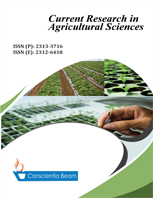Bacteriological Quality and Cyanide Contents of Different Cassava Products Processed in Benue State for Use as Food for Man or Feedstock for Animals
DOI:
https://doi.org/10.18488/journal.68.2021.81.47.55Abstract
The bacteriological profiles of the different cassava products were investigated. Ground cassava samples, serially diluted with sterile normal saline were cultured in different sterile bacteriological media. Hydrogen cyanide content was determined by spectrometric method. Colonies isolated from the different locations were statistically the same for total viable bacterial counts (TVBC). Cassava peels had the highest values of TVBC (4.456 log10CFU/g) TCC (3.025 log10CFU/g) EC (1.663) and SA counts. Gari had the lowest values of TVBC (3.193) TCC (2.580) EC (not isolated) and SA counts. The traditionally processed cassava products showed no statistically significant differences (p<0.05) with the mechanically processed products except in fufu. The total viable bacterial count was highest in cassava products dried along the roadside (6.980 log10CFU/g) and lowest oven-dried cassava products (2.763 log10CFU/g). No Salmonella and Shigella spp. were isolated in most of the assayed cassava products. The identified storage places of the cassava products did not significantly impact any difference on the bacterial load. There was a progressive decrease in the cyanide contents from cassava peels to cassava chips to fufu and least in gari. The highest hydrogen cyanide concentration of 14.50 mg/kg was recorded in cassava peels and was higher than 10 mg of HCN/kg body weight recommended by WHO. Gari had the least content of 2.25 mg/kg. The study provides information on potential infections and toxicities due to the microorganisms and cyanide level.

